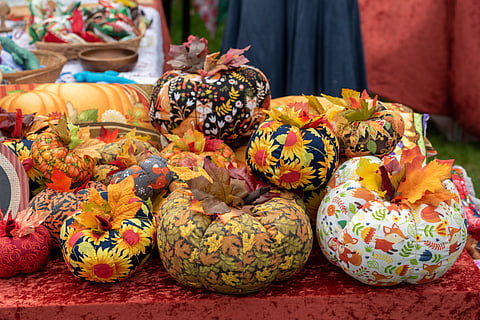
- Destinations
- Experiences
- Stay
- What's new
- Editor’s Picks
- Responsible Tourism
- CampaignsCampaigns
- Subscribe

October means Halloween season. While the holiday itself is held on October 31, the weeks leading up to it are a hotbed of costume discussion, drinking pumpkin spice lattes (in America primarily), stocking up on candy and chocolates to give trick-or-treaters, and carving pumpkin lanterns, if one can find them. The secular traditions of Halloween belie its pagan and religious roots in Celtic countries like Ireland and Scotland, but the day itself was popularised by the Americans. However, that does not take away from how much fun Halloween is to celebrate with family and friends.
Before you go apple bobbing and plan your visit to haunted attractions, read up on how All Hallows’ Eve is celebrated in places around the world.
The North American country of Mexico celebrates el Día de Muertos (“the Day of the Dead”) on November 1 and 2. The 3,000-year-old festival is a multi-day holiday where family and friends gather to pay respects and to remember their dead loved ones. These celebrations can take a humorous tone, as celebrants remember amusing events and anecdotes about the departed. Family members may prepare a feast with the deceased's favourite foods or leave gifts on their gravesite. Festival-goers will don skull masks and eat skull-shaped sweets. The vibrant festival was the centrepiece of the 2017 film “Coco.”
Samhain, also known as Oíche Shamhna, is a Gaelic festival that is celebrated on November 1 to mark the end of the harvest season and the beginning of winter. It is also the Irish language name for November. Celebrations begin on the evening of October 31, since the Celtic day began and ended at sunset. According to one theory, Halloween originated from Samhain, while others suggest that the Celtic festival may have been Christianised as All Hallow's Day by the early Catholic Church. Festivals in Ireland take place across the country: from the Púca festival, which celebrates the folklore behind the Celtic holiday, to the Derry Halloween celebration in the northern part of the island.
Undas is the Filipino term for All Saints’ Day and All Souls’ Day, both of which are religious holidays. Families visit cemeteries to clean and decorate graves, lighting candles and offering prayers for their loved ones. In some regions, children participate in pangangaluluwa, a tradition similar to trick-or-treating, where they sing songs in exchange for food or money intended for souls in purgatory. Filipinos are said to have adopted the festive aspect of Halloween from the Mexicans during the Spanish occupation era, particularly the feast of el Día de Muertos. However, most people in the country have adopted the American way of celebrating Halloween, going trick-or-treating and holding costume parties.
Ognissanti (All Saints) is celebrated on November 1 and 2 in Italy and is dedicated to loved ones who have passed away. People start visiting cemeteries some days before so that on the two festive days, fresh flowers—which are also left on old and forgotten tombs—give an explosion of colour to what can be a sombre place. Folk traditions include lighting a lumino (red candle) at sunset and laying a table for the deceased who will come to visit. In Sicily, the custom is to prepare gifts and sweets for the children, who are told that the deceased relatives brought them. In Bormio, it is customary to put a pumpkin on the windowsill filled with wine, while in Abruzzo, pumpkins are decorated, and kids go knocking from house to house asking for gifts for the souls of the dead—much like present-day Halloween.
Guy Fawkes Night, also known as Guy Fawkes Day, Bonfire Night and Fireworks Night, is observed on November 5 in Great Britain. Its history begins with the events of November 5, 1605, when Guy Fawkes, a member of the Gunpowder Plot, was arrested while guarding explosives he and his fellow plotters had placed beneath the House of Lords. The Catholic conspiracists had intended to assassinate Protestant King James I and his parliament, but the plot was foiled. Celebrating the king's survival, people lit bonfires around London, which they continue to do today. Instead of trick-or-treating for candy, children will walk around asking for a "penny for the Guy."
